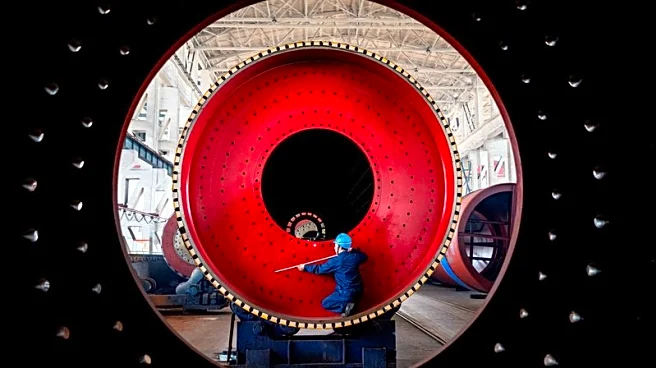What's Happening?
China's manufacturing sector is experiencing a significant contraction, with the official Purchasing Managers' Index (PMI) falling to 49.0 in October, marking the seventh consecutive month below the 50-point
threshold. This downturn is prompting a shift in global production capacity, with capital moving from China to Southeast Asia and India. The U.S. trade policy, which imposes high tariffs on Chinese goods, is a contributing factor. As a result, countries like Vietnam, Thailand, Malaysia, and Indonesia are emerging as new manufacturing hubs, benefiting from the 'China-plus-one' strategy. These countries are attracting foreign direct investment and developing their industrial capabilities, particularly in sectors like electronics, automotive, and semiconductors.
Why It's Important?
The shift in manufacturing from China to Southeast Asia and India has significant implications for global supply chains and economic dynamics. It reflects a strategic realignment driven by geopolitical tensions and trade barriers. The U.S. aims to limit China's industrial growth, but the relocation of manufacturing has not resulted in a significant return of production to the U.S. Instead, Southeast Asian countries are becoming key players in the global manufacturing landscape. This transition offers opportunities for investors in industrial real estate, logistics, and automation technology in these regions. It also highlights the growing importance of Southeast Asia in the global economy, as these countries develop into diversified manufacturing and automation markets.
What's Next?
As manufacturing continues to shift to Southeast Asia, these countries are likely to see increased investment in infrastructure and technology. The development of advanced manufacturing zones and the integration of automation technology will be crucial for sustaining growth. Additionally, the U.S. may continue to refine its trade policies to address the evolving global manufacturing landscape. For investors, understanding the nuances of this transition will be key to identifying opportunities in industrial real estate, automation, and energy-transition metals. The long-term impact on China's economy and its role in global supply chains will also be an area of focus.
Beyond the Headlines
The manufacturing shift has deeper implications for global economic power dynamics. It underscores the importance of geopolitical strategies in shaping economic outcomes and highlights the interconnectedness of global supply chains. The rise of Southeast Asia as a manufacturing hub could lead to increased regional cooperation and economic integration. Additionally, the focus on automation and advanced manufacturing technologies may drive innovation and productivity gains in these countries, further enhancing their competitiveness on the global stage.













